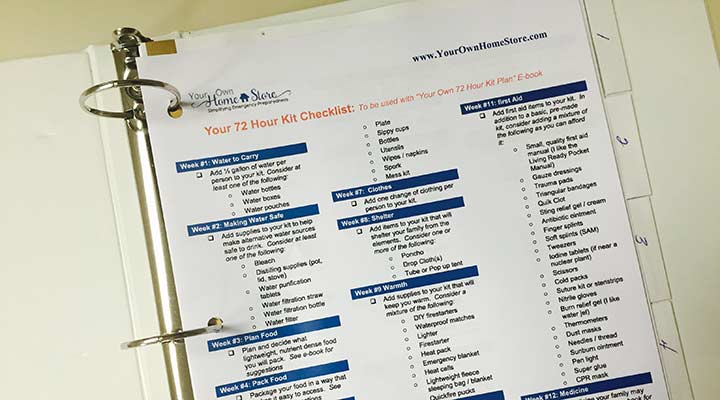
Build Your Own Survival Kit to Stay Prepared
Mar 31, 2023 / Alyssa Duranty
You’ve probably heard it time and time again: It’s not a matter of if a natural disaster is going to happen, it’s a matter of when. So it’s important to prepare your family for emergencies by learning how to organize and build your own survival kit — for when danger knocks at your door without an invitation.
Summer is tornado, wildfire, hurricane, and even flood season depending on where you are in the country. But once the bad news hits the TV or radio, it can be too late to plan.
“You don’t really think about preparedness or (getting) kits together until it’s too late,”; said Rob Glenn, director of the private sector division of the Federal Emergency Management Agency.
To inspire you to plan ahead for the worst, we talked to experts like Glenn for tips to make your own survival kit, and store it, so your home can stay organized while you stay prepared.
Pack Essentials When You Build Your Own Survival Kit
It’s important to have enough supplies to last you at least three days, said Glenn of FEMA, who suggests asking an important question as you’re deciding on essentials: “If you were to go on a camping trip, what would you bring with you?”;
Water is the most important supply, and you should make sure to store enough, Glenn said. Pack a gallon per day, per family member. Also consider purchasing a water filter straw, just in case you need to drink from a natural source like a river or lake.
Misty Marsh, who provides expert emergency preparedness tips on her then website known as Your Own Home Store and now is named Simple Family Preparedness, said you should consider five important things, besides food and water, when you set aside essentials for emergencies: shelter, first aid (including medications), lights, tools, documents and individual needs (religion, kids, pets, etc.).
On her downloadable lists of survival supplies, she suggests collecting items like waterproof matches, antibiotic ointment and a can opener. Although that’s just a few of the items on her very thorough lists. Marsh also recommends picking lightweight, high–calorie foods like trail mix and granola bars that do not need to be cooked. And don’t forget pet food for your four–legged family members.
Glenn suggests planning to lighten your load when you are on the run from disaster by digitizing important documents and saving them to a USB drive—which you can even store on your key ring—or an online storage system accessed remotely.
Make sure to check your supplies every six months to make sure they haven’t expired. Marsh sets an alarm on her cellphone to remind her to check her kits.
Download emergency essentials checklists from Ready.gov for a more in–depth look at needed supplies, Glenn said.
How to Organize Your Survival Kit
Glenn has different emergency kits in multiple rooms of his house, to distribute the necessities among his wife and kids.
“We have different kits for different family members, so in some degree everyone carries their own weight,”; he said. “That lets us be more mobile in case we do have to evacuate.”;
Marsh also divides her kits among her husband and older children. She said supplies for three days should easily fit inside larger backpacks. Consider buying packs larger than 50 liters for family members big enough to carry them. And consider putting the heaviest items closest to your back, near the middle of the pack.
“You should also consider putting items you may need to grab quick – like first aid items – or often – like food and water – in easy–to–reach places,”; Marsh said.
If your upper body strength is lacking (don’t worry, you’re not alone), consider packing your supplies in a suitcase with wheels and storing it under your bed or in a closet. Your kit should always be near the exit of your home.
Always Have an Emergency Plan in Your Survival Kit
“Natural disasters cause a lot of panic and fear,”; Marsh said. “When we are panicked, we don’t make wise choices. Being prepared will allow us to better care for our family and make smart choices.”;
It’s important to have two meet–up places in your plan: One in the neighborhood and one in a nearby location outside the community, Glenn said.
“You want to be thinking about ‘Do I have everyone’s (phone) numbers?’”; Glenn said. “It’s really important to think about how you’re going to communicate in a disaster.”;
It’s also important to test your disaster plan.
“I know people who run drills once a quarter,”; Glenn said. “They are on the upper end of being prepared. It’s a model to follow.”;
If you want help building a communications plan, or if you’d like more detail on how to be ready for anything life throws your way, FEMA has a free mobile app that can help. It lets you set up alerts for up to five different locations. If you have a family member in Tennessee, you can actually look up how to keep track of that person through National Weather Service alerts.
And for even more details, Marsh wrote an eBook on how to build a 72–hour survival kit, breaking it down into weekly steps.
“You can become a source of strength on your street, in your family, or in your community just by being prepared,”; Glenn said.







